TOYOTA COROLLA HATCHBACK 2019 (in English) Owner's Manual
Manufacturer: TOYOTA, Model Year: 2019, Model line: COROLLA HATCHBACK, Model: TOYOTA COROLLA HATCHBACK 2019Pages: 56, PDF Size: 5.71 MB
Page 21 of 56
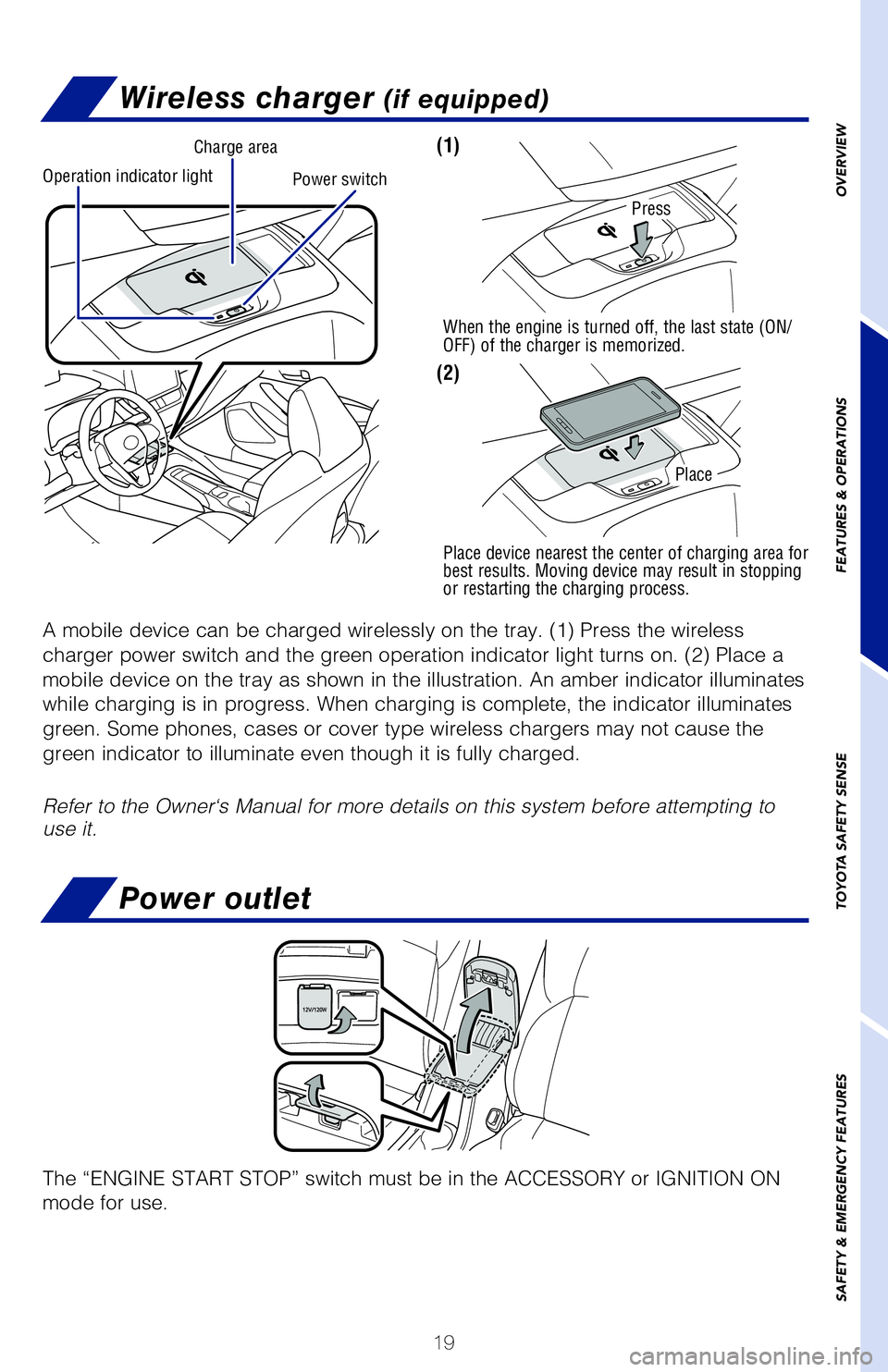
19
OVERVIEW
FEATURES & OPERATIONS
TOYOTA SAFETY SENSE
SAFETY & EMERGENCY FEATURES
Audio
ENTUNE™
3.0 AUDIO PLUS
ENTUNE™ 3.0 AUDIO
ENTUNE™ 3.0 PREMIUM AUDIO, WITH APP SUITE AND DYNAMIC
NAVIGATION
NOTE: Concentrating on the road should always be your first priority while
driving. Do not use the Entune system if it will distract you.
Visually match your vehicle’s Entune
TM 3.0 audio system to one featured in
this guide for the most accurate information.
Refer to the “Navigation System Owner’s Manual” or visit www.to\
yota.com/entune
for additional audio/multimedia resources.
Turn to tune radio stations
manually or select tracks or files Access
Bluetooth
hands-free system
Seek
station/CD
track select
Access
APPS screen
Wireless charger (if equipped)
A mobile device can be charged wirelessly on the tray. (1) Press the w\
ireless
charger power switch and the green operation indicator light turns on. (\
2) Place a
mobile device on the tray as shown in the illustration. An amber indicat\
or illuminates
while charging is in progress. When charging is complete, the indicator \
illuminates
green. Some phones, cases or cover type wireless chargers may not cause \
the
green indicator to illuminate even though it is fully charged.
Refer to the Owner‘s Manual for more details on this system before at\
tempting to
use it.
Power switch
Charge area
Operation indicator light
Press
When the engine is turned off, the last state (ON/
OFF) of the charger is memorized.
Place device nearest the center of charging area for
best results. Moving device may result in stopping
or restarting the charging process.
Place
(1)
(2)
USB charge-port
Power outlet
The “ENGINE START STOP” switch must be in the ACCESSORY or IGNITIO\
N ON
mode for use.
2019_Corolla_HB_QRG_V5_0516.indd 195/17/18 11:12 PM
Page 22 of 56
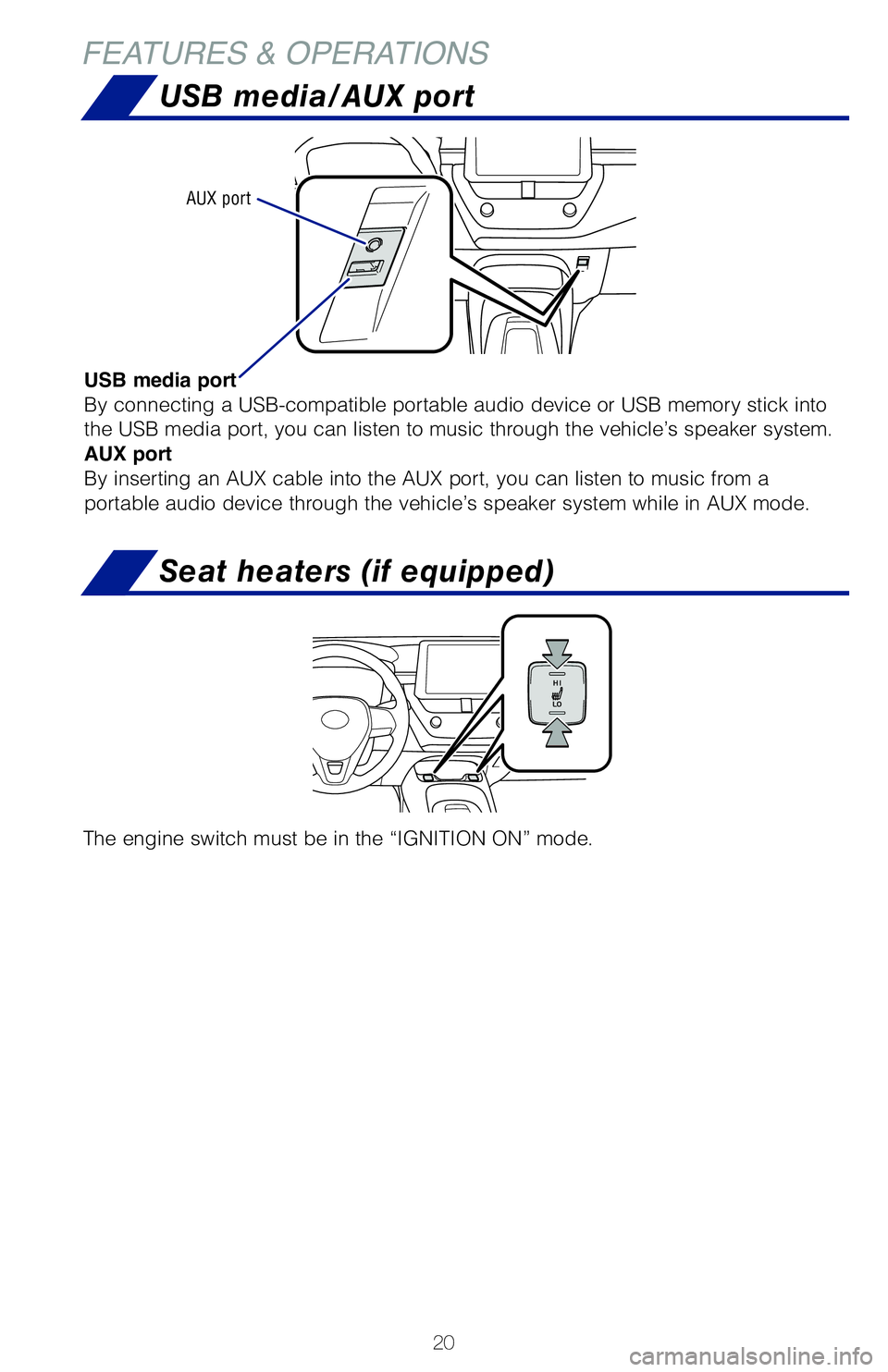
20
FEATURES & OPERATIONS
USB media/AUX port
USB media port
By connecting a USB-compatible portable audio device or USB memory stick\
into
the USB media port, you can listen to music through the vehicle’s spe\
aker system.
AUX port
By inserting an AUX cable into the AUX port, you can listen to music fro\
m a
portable audio device through the vehicle’s speaker system while in A\
UX mode.
WITHOUT DUAL AIR CONDITIONING SYSTEM
WITH DUAL AIR CONDITIONING SYSTEM
Automatic climate control ON
Adjusting the temperature setting
will cause the airflow vents,
air intake and fan to adjust
automatically.
Automatic climate control ON
Adjusting the temperature setting
will cause the airflow vents,
air intake and fan to adjust
automatically.
Seat heaters (if equipped)
The engine switch must be in the “IGNITION ON” mode.
AUX port
2019_Corolla_HB_QRG_V5_0516.indd 205/17/18 11:12 PM
Page 23 of 56
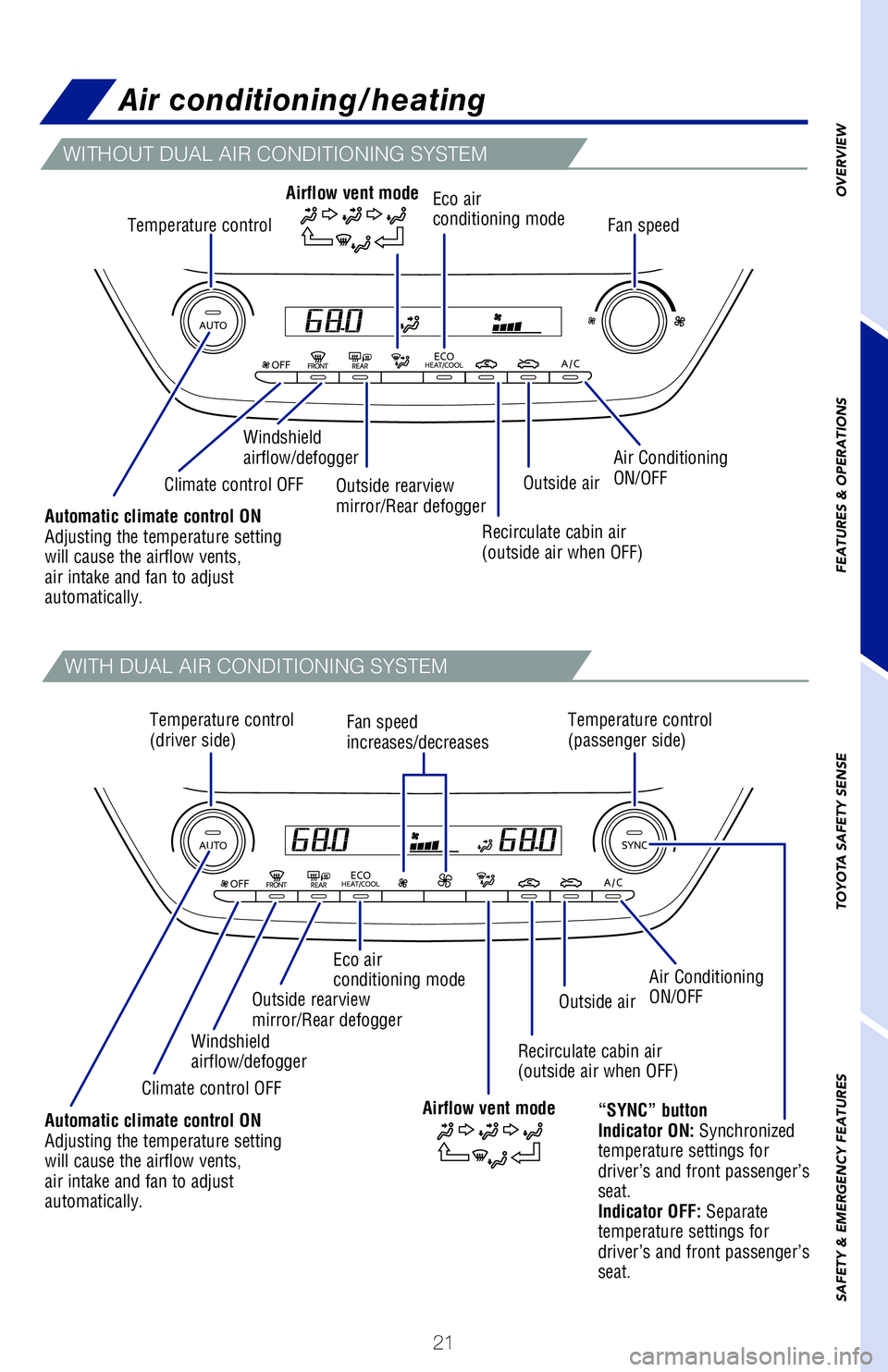
21
OVERVIEW
FEATURES & OPERATIONS
TOYOTA SAFETY SENSE
SAFETY & EMERGENCY FEATURES
Air conditioning/heating
USB media port
By connecting a USB-compatible portable audio device or USB memory stick\
into
the USB media port, you can listen to music through the vehicle’s spe\
aker system.
AUX port
By inserting an AUX cable into the AUX port, you can listen to music fro\
m a
portable audio device through the vehicle’s speaker system while in A\
UX mode.
WITHOUT DUAL AIR CONDITIONING SYSTEM
WITH DUAL AIR CONDITIONING SYSTEM
Temperature control
Temperature control
(driver side) Temperature control
(passenger side)
Fan speed
increases/decreases Fan speed
Windshield
airflow/defogger
Windshield
airflow/defogger Air Conditioning
ON/OFF
Air Conditioning
ON/OFF
Climate control OFF
Climate control OFF Eco air
conditioning mode
Eco air
conditioning mode
Automatic climate control ON
Adjusting the temperature setting
will cause the airflow vents,
air intake and fan to adjust
automatically.
Automatic climate control ON
Adjusting the temperature setting
will cause the airflow vents,
air intake and fan to adjust
automatically.
Airflow vent mode
Airflow vent mode
Outside rearview
mirror/Rear defogger
Outside rearview
mirror/Rear defogger Recirculate cabin air
(outside air when OFF)
Recirculate cabin air
(outside air when OFF)Outside air
Outside air
Seat heaters (if equipped)
The engine switch must be in the “IGNITION ON” mode.
“SYNC” button
Indicator ON: Synchronized
temperature settings for
driver’s and front passenger’s
seat.
Indicator OFF: Separate
temperature settings for
driver’s and front passenger’s
seat.
2019_Corolla_HB_QRG_V5_0516.indd 215/17/18 11:12 PM
Page 24 of 56
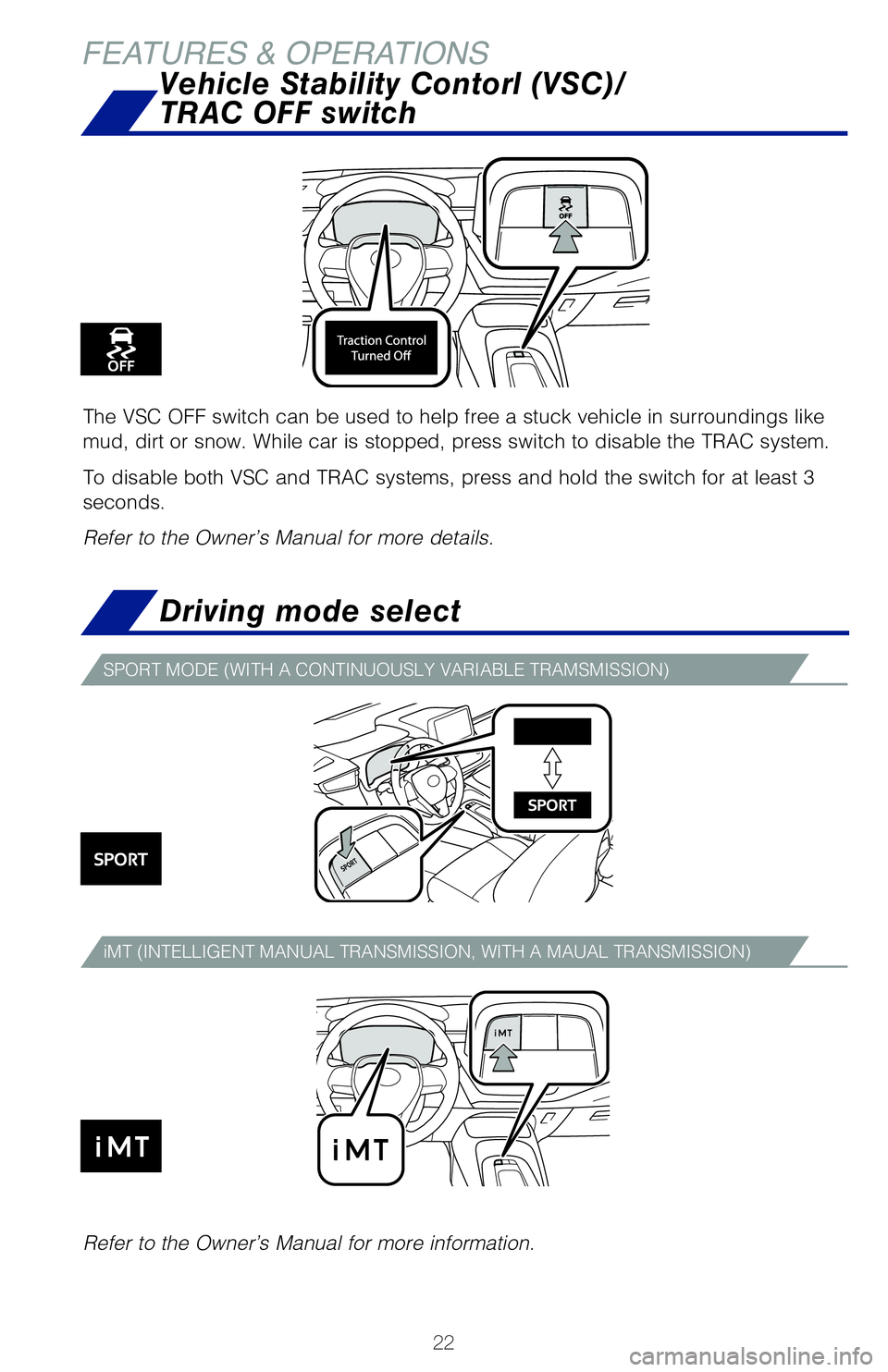
22
FEATURES & OPERATIONSDriving mode select
The rear view monitor system displays an image of the view from the bump\
er of
the rear area of the vehicle. The camera for the rear view monitor syste\
m is located
above the license plate.
To adjust the image on the rear view monitor screen, press the “MENU”\
button and
select “Display” on the screen. Select “Camera” to adjust th\
e screen contrast and
brightness.
Refer to the Owner’s Manual and the Navigation Owner‘s Manual for \
limitations and
more details on this system.
The system is designed to use radar sensors to detect vehicles traveling\
in the
Corolla Hatchback’s blind spot and advises the driver of the vehicles\
’ presence via
the outside rear view mirror indicators.
Refer to the Owner‘s Manual for limitations and more details on this \
system before
attempting to use it.
Outside rear view mirror indicators
iMT (INTELLIGENT MANUAL TRANSMISSION, WITH A MAUAL TRANSMISSION)
SPORT MODE (WITH A CONTINUOUSLY VARIABLE TRAMSMISSION)
Refer to the Owner’s Manual for more information.
Vehicle Stability Contorl (VSC)/
TRAC OFF switch
The VSC OFF switch can be used to help free a stuck vehicle in surroundi\
ngs like
mud, dirt or snow. While car is stopped, press switch to disable the TRA\
C system.
To disable both VSC and TRAC systems, press and hold the switch for at l\
east 3
seconds.
Refer to the Owner’s Manual for more details.
2019_Corolla_HB_QRG_V5_0516.indd 225/17/18 11:12 PM
Page 25 of 56
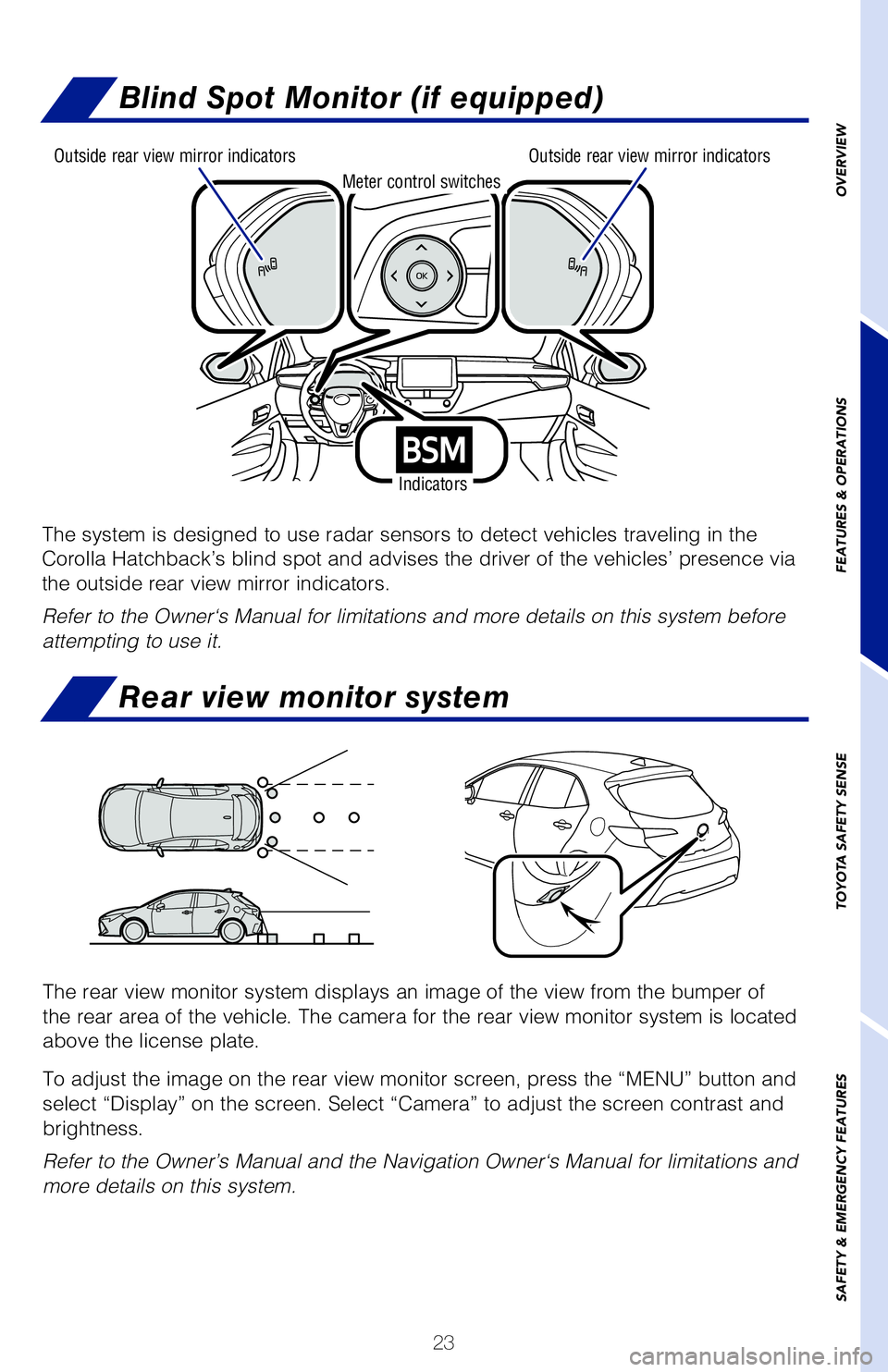
23
OVERVIEW
FEATURES & OPERATIONS
TOYOTA SAFETY SENSE
SAFETY & EMERGENCY FEATURES
Driving mode select
Rear view monitor system
The rear view monitor system displays an image of the view from the bump\
er of
the rear area of the vehicle. The camera for the rear view monitor syste\
m is located
above the license plate.
To adjust the image on the rear view monitor screen, press the “MENU”\
button and
select “Display” on the screen. Select “Camera” to adjust th\
e screen contrast and
brightness.
Refer to the Owner’s Manual and the Navigation Owner‘s Manual for \
limitations and
more details on this system.
The system is designed to use radar sensors to detect vehicles traveling\
in the
Corolla Hatchback’s blind spot and advises the driver of the vehicles\
’ presence via
the outside rear view mirror indicators.
Refer to the Owner‘s Manual for limitations and more details on this \
system before
attempting to use it.
Indicators
Outside rear view mirror indicators
Meter control switches
Outside rear view mirror indicators
Blind Spot Monitor (if equipped)
Refer to the Owner’s Manual for more information.
Vehicle Stability Contorl (VSC)/
TRAC OFF switch
The VSC OFF switch can be used to help free a stuck vehicle in surroundi\
ngs like
mud, dirt or snow. While car is stopped, press switch to disable the TRA\
C system.
To disable both VSC and TRAC systems, press and hold the switch for at l\
east 3
seconds.
Refer to the Owner’s Manual for more details.
2019_Corolla_HB_QRG_V5_0516.indd 235/17/18 11:12 PM
Page 26 of 56
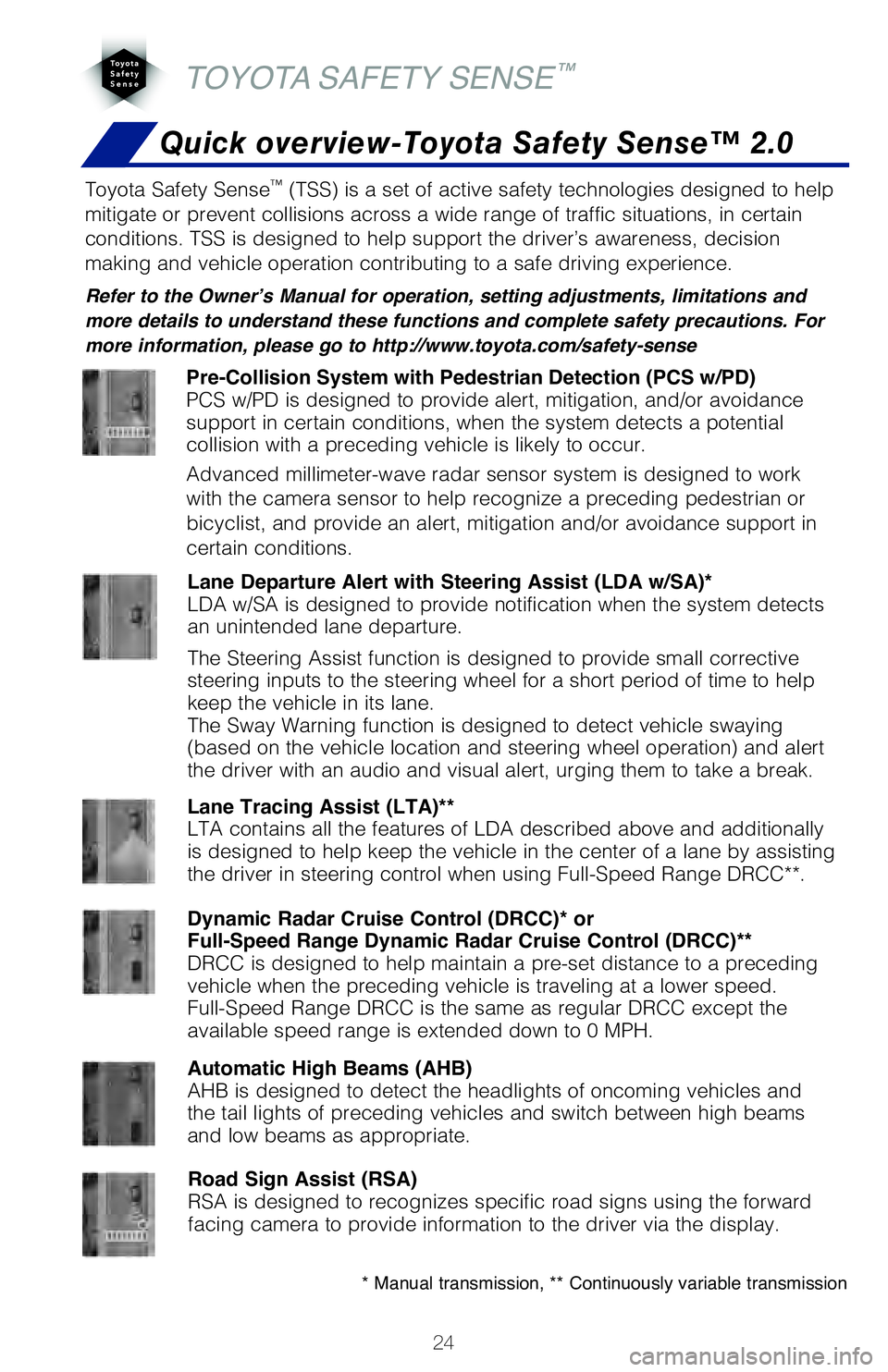
24
TOYOTA SAFETY SENSE™
Toyota Safety Sense™ (TSS) is a set of active safety technologies designed to help
mitigate or prevent collisions across a wide range of traffic situations\
, in certain
conditions. TSS is designed to help support the driver’s awareness, d\
ecision
making and vehicle operation contributing to a safe driving experience.
Refer to the Owner’s Manual for operation, setting adjustments, limitations and
more details to understand these functions and complete safety precautions. For
more information, please go to http://www.toyota.com/safety-sense
TSS-P combines an in-vehicle camera mounted in front of the inside rear \
view mirror
and a radar mounted in the front grill. These sensors support the driver\
assist systems.
The Pre-Collision System uses a radar sensor and camera sensor to help d\
etect a
vehicle or pedestrian or bicyclist in front of your vehicle.
As there is a limit to the degree of recognition accuracy and control pe\
rformance that
this system can provide, do not overly rely on this system. This system \
will not prevent
collisions or lessen collision damage or injury in every situation. Do n\
ot use PCS
instead of normal braking operations under any circumstances. Do not att\
empt to test
the operation of the Pre-Collision System yourself, as the system may no\
t operate or
engage, possibly leading to an accident. In some situations, such as whe\
n driving in
inclement weather such as heavy rain, fog, snow or a sandstorm or while \
driving on a
curve and for a few seconds after driving on a curve, a vehicle may not \
be detected
by the radar and camera sensors, preventing the system from operating or\
engaging
properly.
Refer to a Toyota Owner’s Manual for a list of additional situations \
in which the
system may not operate properly. Pre-Collision Warning
When the system determines that the possibility of a frontal collision i\
s high, a buzzer
will sound and a warning message will be displayed on the Multi-Informat\
ion Display
(MID) to urge the driver to take evasive action.
Pre-Collision Brake Assist
If the driver notices the hazard and brakes, the system may provide addi\
tional braking
force using Brake Assist. This system may prime the brakes and may apply\
greater
braking force in relation to how strongly the brake pedal is depressed.Quick overview-Toyota Safety Sense™ 2.0
Lane Departure Alert with Steering Assist (LDA w/SA)*
LDA w/SA is designed to provide notification when the system detects
an unintended lane departure.
The Steering Assist function is designed to provide small corrective
steering inputs to the steering wheel for a short period of time to help\
keep the vehicle in its lane.
The Sway Warning function is designed to detect vehicle swaying
(based on the vehicle location and steering wheel operation) and alert\
the driver with an audio and visual alert, urging them to take a break.
Automatic High Beams (AHB)
AHB is designed to detect the headlights of oncoming vehicles and
the tail lights of preceding vehicles and switch between high beams
and low beams as appropriate. Road Sign Assist (RSA)
RSA is designed to recognizes specific road signs using the forward
facing camera to provide information to the driver via the display.
Pre-Collision System with Pedestrian Detection (PCS w/PD)
PCS w/PD is designed to provide alert, mitigation, and/or avoidance
support in certain conditions, when the system detects a potential
collision with a preceding vehicle is likely to occur.
Advanced millimeter-wave radar sensor system is designed to work
with the camera sensor to help recognize a preceding pedestrian or
bicyclist, and provide an alert, mitigation and/or avoidance support in \
certain conditions.
Dynamic Radar Cruise Control (DRCC)* or
Full-Speed Range Dynamic Radar Cruise Control (DRCC)**
DRCC is designed to help maintain a pre-set distance to a preceding
vehicle when the preceding vehicle is traveling at a lower speed.
Full-Speed Range DRCC is the same as regular DRCC except the
available speed range is extended down to 0 MPH.
Lane Tracing Assist (LTA)**
LTA contains all the features of LDA described above and additionally
is designed to help keep the vehicle in the center of a lane by assistin\
g
the driver in steering control when using Full-Speed Range DRCC**.
* Manual transmission, ** Continuously variable transmission
2019_Corolla_HB_QRG_V5_0516.indd 245/17/18 11:12 PM
Page 27 of 56
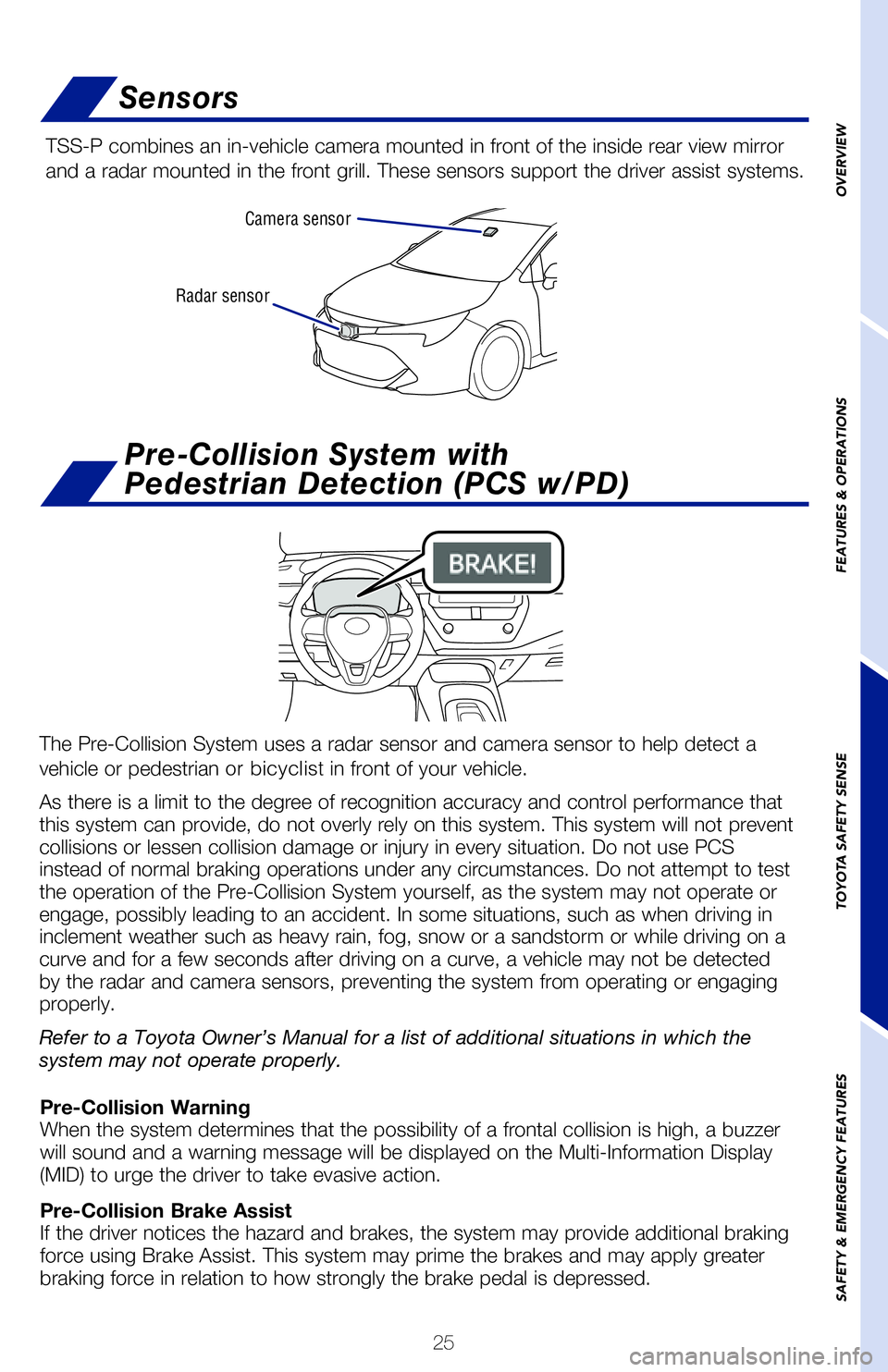
25
OVERVIEW
FEATURES & OPERATIONS
TOYOTA SAFETY SENSE
SAFETY & EMERGENCY FEATURES
Radar sensor Camera sensor
Sensors
Toyota Safety Sense™ (TSS) is a set of active safety technologies designed to help
mitigate or prevent collisions across a wide range of traffic situations\
, in certain
conditions. TSS is designed to help support the driver’s awareness, d\
ecision
making and vehicle operation contributing to a safe driving experience.
Refer to the Owner’s Manual for operation, setting adjustments, limitations and
more details to understand these functions and complete safety precautions. For
more information, please go to http://www.toyota.com/safety-sense
TSS-P combines an in-vehicle camera mounted in front of the inside rear \
view mirror
and a radar mounted in the front grill. These sensors support the driver\
assist systems.
The Pre-Collision System uses a radar sensor and camera sensor to help d\
etect a
vehicle or pedestrian or bicyclist in front of your vehicle.
As there is a limit to the degree of recognition accuracy and control pe\
rformance that
this system can provide, do not overly rely on this system. This system \
will not prevent
collisions or lessen collision damage or injury in every situation. Do n\
ot use PCS
instead of normal braking operations under any circumstances. Do not att\
empt to test
the operation of the Pre-Collision System yourself, as the system may no\
t operate or
engage, possibly leading to an accident. In some situations, such as whe\
n driving in
inclement weather such as heavy rain, fog, snow or a sandstorm or while \
driving on a
curve and for a few seconds after driving on a curve, a vehicle may not \
be detected
by the radar and camera sensors, preventing the system from operating or\
engaging
properly.
Refer to a Toyota Owner’s Manual for a list of additional situations \
in which the
system may not operate properly.
Pre-Collision Warning
When the system determines that the possibility of a frontal collision i\
s high, a buzzer
will sound and a warning message will be displayed on the Multi-Informat\
ion Display
(MID) to urge the driver to take evasive action.
Pre-Collision Brake Assist
If the driver notices the hazard and brakes, the system may provide addi\
tional braking
force using Brake Assist. This system may prime the brakes and may apply\
greater
braking force in relation to how strongly the brake pedal is depressed.
Quick overview-Toyota Safety Sense™ 2.0
Lane Departure Alert with Steering Assist (LDA w/SA)*
LDA w/SA is designed to provide notification when the system detects
an unintended lane departure.
The Steering Assist function is designed to provide small corrective
steering inputs to the steering wheel for a short period of time to help\
keep the vehicle in its lane.
The Sway Warning function is designed to detect vehicle swaying
(based on the vehicle location and steering wheel operation) and alert\
the driver with an audio and visual alert, urging them to take a break.
Automatic High Beams (AHB)
AHB is designed to detect the headlights of oncoming vehicles and
the tail lights of preceding vehicles and switch between high beams
and low beams as appropriate. Road Sign Assist (RSA)
RSA is designed to recognizes specific road signs using the forward
facing camera to provide information to the driver via the display.
Pre-Collision System with Pedestrian Detection (PCS w/PD)
PCS w/PD is designed to provide alert, mitigation, and/or avoidance
support in certain conditions, when the system detects a potential
collision with a preceding vehicle is likely to occur.
Advanced millimeter-wave radar sensor system is designed to work
with the camera sensor to help recognize a preceding pedestrian or
bicyclist, and provide an alert, mitigation and/or avoidance support in \
certain conditions.
Dynamic Radar Cruise Control (DRCC)* or
Full-Speed Range Dynamic Radar Cruise Control (DRCC)**
DRCC is designed to help maintain a pre-set distance to a preceding
vehicle when the preceding vehicle is traveling at a lower speed.
Full-Speed Range DRCC is the same as regular DRCC except the
available speed range is extended down to 0 MPH.
Lane Tracing Assist (LTA)**
LTA contains all the features of LDA described above and additionally
is designed to help keep the vehicle in the center of a lane by assistin\
g
the driver in steering control when using Full-Speed Range DRCC**.
Pre-Collision System with
Pedestrian Detection (PCS w/PD)
* Manual transmission, ** Continuously variable transmission
2019_Corolla_HB_QRG_V5_0516.indd 255/17/18 11:12 PM
Page 28 of 56
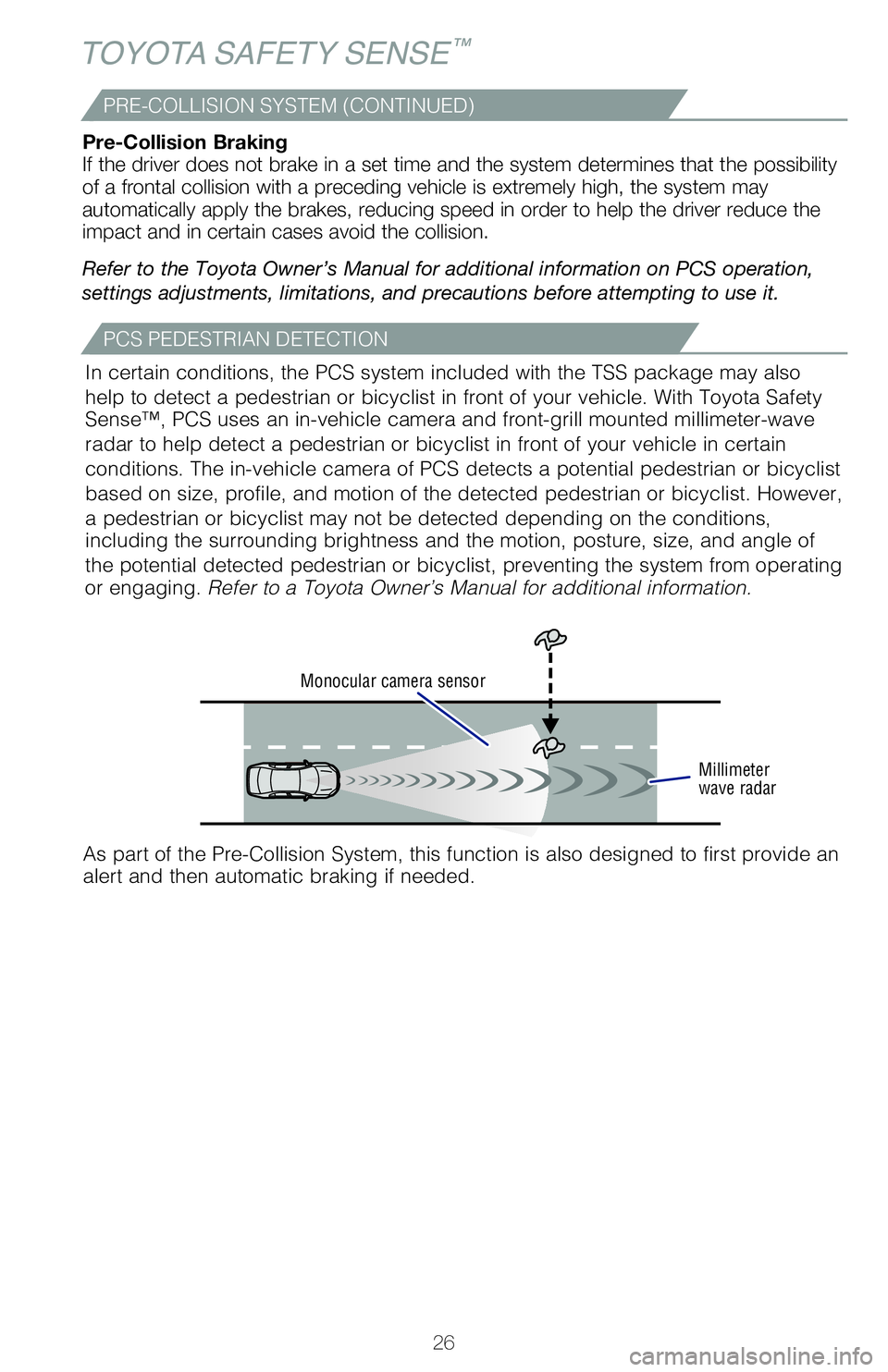
26
CHANGING PRE-COLLISION ALERT TIMINGPRE-COLLISION SYSTEM (CONTINUED)
DISABLING PRE-COLLISION SYSTEM (PCS)
Each time the PCS switch is pressed, the response to the PCS alert timin\
g changes.
TOYOTA SAFETY SENSE™
Refer to the Toyota Owner’s Manual for additional information on PCS \
operation,
settings adjustments, limitations, and precautions before attempting to \
use it. Pre-Collision Braking
If the driver does not brake in a set time and the system determines tha\
t the possibility
of a frontal collision with a preceding vehicle is extremely high, the s\
ystem may
automatically apply the brakes, reducing speed in order to help the driv\
er reduce the
impact and in certain cases avoid the collision.
Monocular camera sensorMillimeter
wave radar
As part of the Pre-Collision System, this function is also designed to f\
irst provide an
alert and then automatic braking if needed.In certain conditions, the PCS system included with the TSS package may \
also
help to detect a pedestrian or bicyclist in front of your vehicle. With \
Toyota Safety
Sense™, PCS uses an in-vehicle camera and front-grill mounted millime\
ter-wave
radar to help detect a pedestrian or bicyclist in front of your vehicle \
in certain
conditions. The in-vehicle camera of PCS detects a potential pedestrian \
or bicyclist
based on size, profile, and motion of the detected pedestrian or bicycli\
st. However,
a pedestrian or bicyclist may not be detected depending on the condition\
s,
including the surrounding brightness and the motion, posture, size, and \
angle of
the potential detected pedestrian or bicyclist, preventing the system fr\
om operating
or engaging. Refer to a Toyota Owner’s Manual for additional information.
PCS PEDESTRIAN DETECTION
(1) Press “ ” switches and select from the Multi-Information Display (MID).
(2) Press “ ” switches and select
from the MID and then press
“”. The setting screen is displayed.
(3) Press “
” each time to change the setting. Each time it is pressed, the
response to the PCS alert timing changes as shown above. You can press “\
” to
go back to the menu.
Note: PCS is enabled each time the engine switch is turned to Ignition On.
The system can be disabled/enabled and the alert timing of the system can be
changed. (Alert timing only, brake operation remains the same).
(1) Press “ ” switches and select
from the Multi-Information Display (MID).
(2) Press “ ” and “
” switches to change the setting.
(3) Press “
” to go back to the menu.
Note: The system is enabled each time the power switch is turned to ON
mode.
Refer to a Toyota Owner’s Manual for additional information on PCS op\
eration,
settings adjustments, limitations, and precautions before attempting to \
use it.
2019_Corolla_HB_QRG_V5_0516.indd 265/17/18 11:12 PM
Page 29 of 56
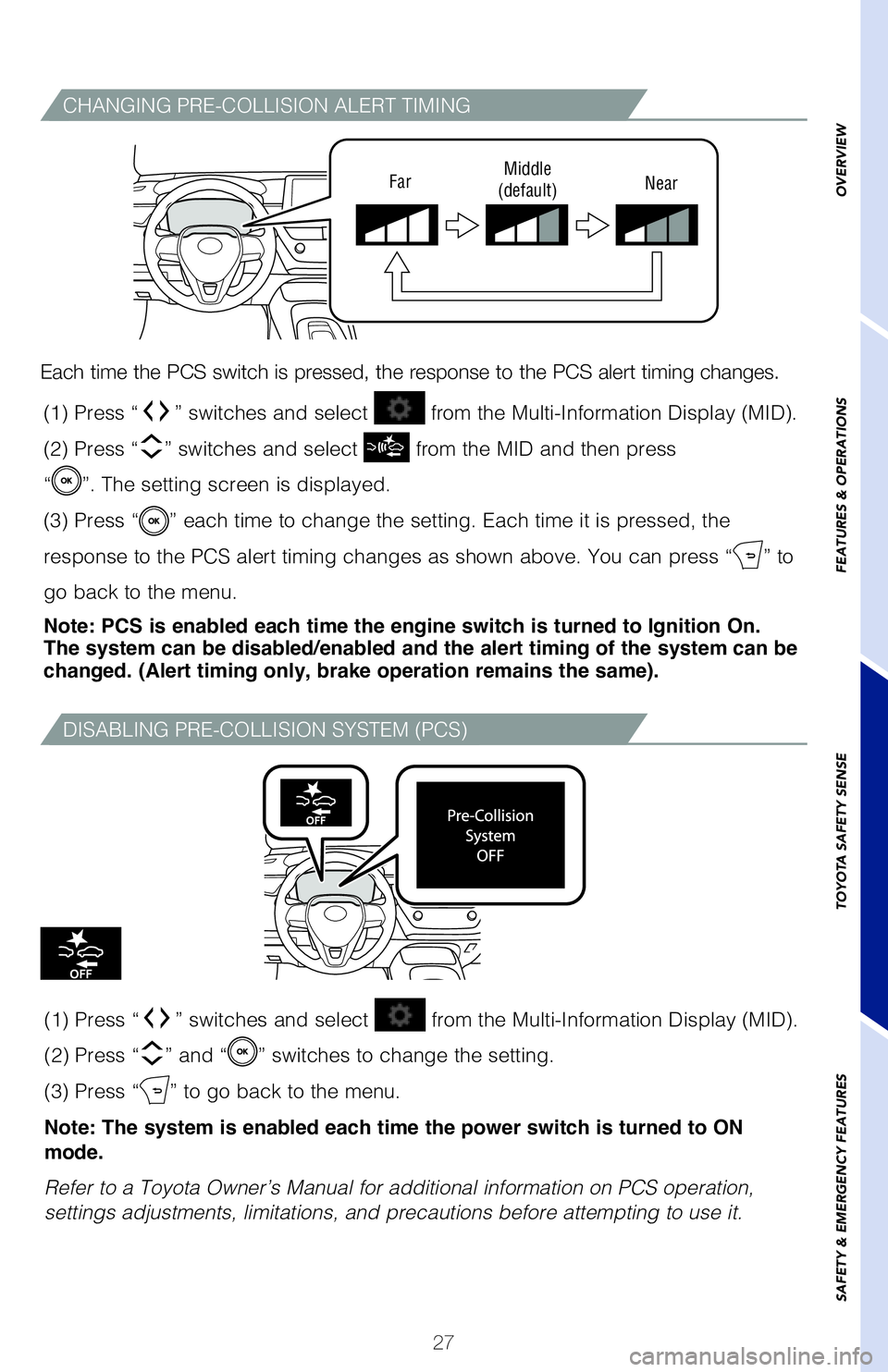
27
OVERVIEW
FEATURES & OPERATIONS
TOYOTA SAFETY SENSE
SAFETY & EMERGENCY FEATURES
CHANGING PRE-COLLISION ALERT TIMING
DISABLING PRE-COLLISION SYSTEM (PCS)
Each time the PCS switch is pressed, the response to the PCS alert timin\
g changes.
Far Middle
(default) Near
Refer to the Toyota Owner’s Manual for additional information on PCS \
operation,
settings adjustments, limitations, and precautions before attempting to \
use it. Pre-Collision Braking
If the driver does not brake in a set time and the system determines tha\
t the possibility
of a frontal collision with a preceding vehicle is extremely high, the s\
ystem may
automatically apply the brakes, reducing speed in order to help the driv\
er reduce the
impact and in certain cases avoid the collision.
As part of the Pre-Collision System, this function is also designed to f\
irst provide an
alert and then automatic braking if needed. In certain conditions, the PCS system included with the TSS package may \
also
help to detect a pedestrian or bicyclist in front of your vehicle. With \
Toyota Safety
Sense™, PCS uses an in-vehicle camera and front-grill mounted millime\
ter-wave
radar to help detect a pedestrian or bicyclist in front of your vehicle \
in certain
conditions. The in-vehicle camera of PCS detects a potential pedestrian \
or bicyclist
based on size, profile, and motion of the detected pedestrian or bicycli\
st. However,
a pedestrian or bicyclist may not be detected depending on the condition\
s,
including the surrounding brightness and the motion, posture, size, and \
angle of
the potential detected pedestrian or bicyclist, preventing the system fr\
om operating
or engaging. Refer to a Toyota Owner’s Manual for additional information.
(1) Press “” switches and select from the Multi-Information Display (MID).
(2) Press “
” switches and select from the MID and then press
“
”. The setting screen is displayed.
(3) Press “
” each time to change the setting. Each time it is pressed, the
response to the PCS alert timing changes as shown above. You can press “\
” to
go back to the menu.
Note: PCS is enabled each time the engine switch is turned to Ignition On.
The system can be disabled/enabled and the alert timing of the system can be
changed. (Alert timing only, brake operation remains the same).
(1) Press “
” switches and select from the Multi-Information Display (MID).
(2) Press “
” and “” switches to change the setting.
(3) Press “
” to go back to the menu.
Note: The system is enabled each time the power switch is turned to ON
mode.
Refer to a Toyota Owner’s Manual for additional information on PCS op\
eration,
settings adjustments, limitations, and precautions before attempting to \
use it.
2019_Corolla_HB_QRG_V5_0516.indd 275/17/18 11:12 PM
Page 30 of 56
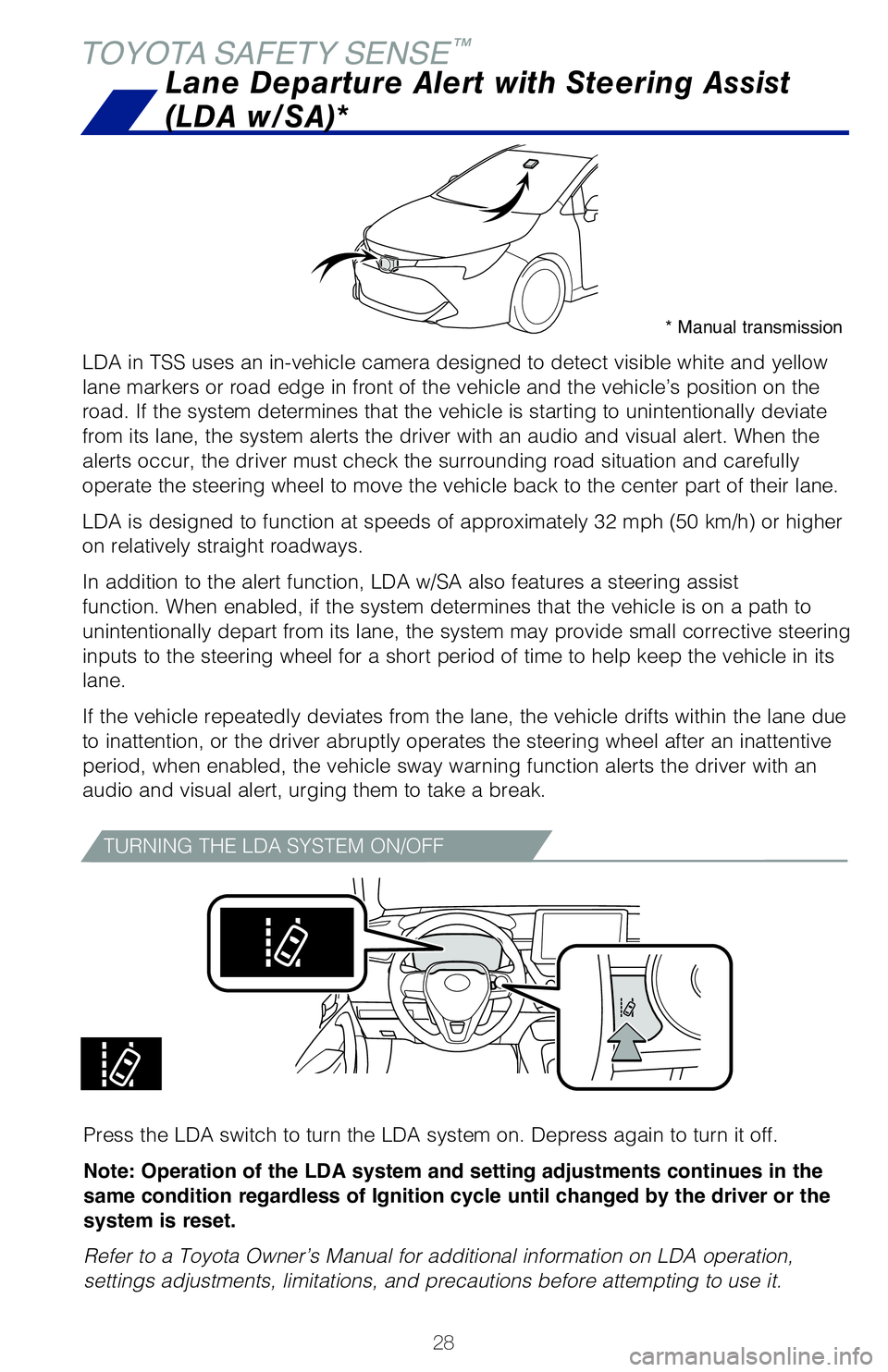
28
TOYOTA SAFETY SENSE™
LDA in TSS uses an in-vehicle camera designed to detect visible white an\
d yellow
lane markers or road edge in front of the vehicle and the vehicle’s p\
osition on the
road. If the system determines that the vehicle is starting to unintenti\
onally deviate
from its lane, the system alerts the driver with an audio and visual ale\
rt. When the
alerts occur, the driver must check the surrounding road situation and c\
arefully
operate the steering wheel to move the vehicle back to the center part o\
f their lane.
LDA is designed to function at speeds of approximately 32 mph (50 km/h)\
or higher
on relatively straight roadways.
In addition to the alert function, LDA w/SA also features a steering ass\
ist
function. When enabled, if the system determines that the vehicle is on \
a path to
unintentionally depart from its lane, the system may provide small corrective steering
inputs to the steering wheel for a short period of time to help keep the\
vehicle in its
lane.
If the vehicle repeatedly deviates from the lane, the vehicle drifts wit\
hin the lane due
to inattention, or the driver abruptly operates the steering wheel after\
an inattentive
period, when enabled, the vehicle sway warning function alerts the drive\
r with an
audio and visual alert, urging them to take a break.
Lane Departure Alert with Steering Assist
(LDA w/SA)*
TURNING THE LDA SYSTEM ON/OFF
Press the LDA switch to turn the LDA system on. Depress again to turn it\
off.
Note: Operation of the LDA system and setting adjustments continues in the
same condition regardless of Ignition cycle until changed by the driver or the
system is reset.
Refer to a Toyota Owner’s Manual for additional information on LDA op\
eration,
settings adjustments, limitations, and precautions before attempting to \
use it.
LANE DEPARTURE ALERT
LDA function display(1)
Lane Departure Alert (LDA) indicator flashes orange when operating.
The LDA function displays when the Multi-Information Display (MID) is switched
to the driving assist system information screen.
(1) The system displays solid white lines on the LDA indicator when vi\
sible lane
markers on the road are detected. A side flashes orange to alert the dri\
ver when the
vehicle deviates from its lane.
(2) The system displays outlines on the LDA indicator when lane markers on the road
are not detected or the function is temporarily cancelled.
Note: When operation conditions are no longer met, a function may be
temporarily canceled. However, when the operation conditions are met again,
operation of the function is automatically restored. For example, LDA may not
function on the side(s) where white/yellow lines are not detectable.
Refer to a Toyota Owner’s Manual for additional information on LDA op\
eration,
settings adjustments, limitations, and precautions before attempting to \
use it.
* Manual transmission
2019_Corolla_HB_QRG_V5_0516.indd 285/17/18 11:12 PM